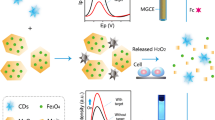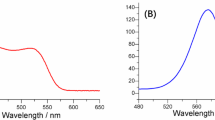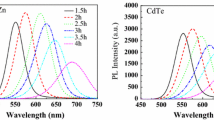Abstract
We fabricated a new and selective fluorescent sensor for the detection of citrate by employing g-C3N4 quantum dots (g-CNQDs) and MgFe layered double hydroxide (MgFe-LDH). The g-CNQDs interacted with MgFe-LDH via electrostatic interaction and the fluorescence of g-CNQDs was effectively quenched by MgFe-LDH due to inner filter effect. Upon addition of citrate, the fluorescence of the g-CNQDs was significantly enhanced, arising from the replacement of g-CNQDs by citrate because citrate competed with g-CNQDs to form more stable complexes with MgFe-LDH. Therefore, we developed a “turn-off–on” fluorescence assay method for the detection of citrate. This method enabled the selective detection of citrate with linear range of 0.5–3.0 μM and 3.0–10.0 μM with a 12.3 nM limit of detection. This method exhibited advantages including easy preparation, environmentally friendly process and rapid response toward citrate.






Similar content being viewed by others
References
Wise DR, Ward PS, Shay JES, Cross JR, Gruber JJ, Sachdeva UM, Platt JM, DeMatteo RG, Simon MC, Thompson CB (2011) Hypoxia promotes isocitrate dehydrogenase-dependent carboxylation of α-ketoglutarate to citrate to support cell growth and viability. Proc Natl Acad Sci U S A 108:19611–19616
Hatzivassiliou G, Zhao FD, Andreadis C, Shaw AN, Dhanak D, Hingorani SR et al (2005) Atp citrate lyase inhibition can suppress tumor cell growth. Cancer Cell 8:311–321
Costello LC, Franklin RB (2006) The clinical relevance of the metabolism of prostate cancer; zinc and tumor suppression: connecting the dots. Mol Cancer 5:17
Muñoz JA, López-Mesas M, Valiente M (2010) Development and validation of a simple determination of urine metabolites (oxalate, citrate, uric acid and creatinine) by capillary zone electrophoresis. Talanta 81:392–397
Cebotaru V, Kaul S, Devuyst O, Cai H, Racusen L, Guggino WB, Guggino SE (2005) High citrate diet delays progression of renal insufficiency in the ClC-5 knockout mouse model of Dent's disease. Kidney Int 68:642–652
Schell-Feith EA, Maerdijk A, Zweiten PHTV, Zanderland HM, Holscher HC, Holthe JK, van der Heijden BJ (2006) Does citrate prevent nephrocalcinosis in preterm neonates? Pediatr.Nephrol. 21:1830–1836
DeBorba BM, Rohrer JS, Bhattacharyya L (2004) Development and validation of an assay for citric acid/citrate and phosphate in pharmaceutical dosage forms using ion chromatography with suppressed conductivity detection. J Pharm Biomed Anal 36:517–524
Chalgeri A, Tan HS (1996) Indirect photometric detection for determination of citrate in pharmaceutical matrices by ion chromatography. J Pharm Biomed Anal 14:835–844
Kelebek H, Selli S, Canbas A, Cabaroglu T (2009) HPLC determination of organic acids, sugars, phenolic compositions and antioxidant capacity of orange juice and orange wine made from a Turkish cv. Kozan, Microchem J 91:187–192
Miyakoshi K, Komoda M (1977) Determination of citric acid and its decomposed products in edible oils by gas liquid chromatography. J Am Oil Chem Soc 54:331–339
Capitan-Vallvey LF, Arroyo-Guerrero E, Fernandez-Ramos MD, Santoyo-Gonzalez F (2005) Development of a one-shot optical citrate sensor based on a guanidinium synthetic receptor. Microchim Acta 151:93–100
Trabesinger AH, Meier D, Dydak U, Lamerichs R, Boesiger P (2005) Optimizing press localized citrate detection at 3 tesla. Magn Reson Med 54:51–58
Zhuo S, Gong J, Ping Z, Zhu C (2015) High-throughput and rapid fluorescent visualization sensor of urinary citrate by cdte quantum dots. Talanta 141:21–25
Liu ZH, Devaraj S, Yang CR, Yen YP (2012) A new selective chromogenic and fluorogenic sensor for citrate ion. Sensors Actuators B Chem 174:555–562
Zhu Z, Zhou J, Li Z, Yang C (2015) Dinuclear zinc complex for fluorescent indicator-displacement assay of citrate. Sensors Actuators B Chem 208:151–158
Li CY, Zhou Y, Li YF, Kong XF, Zou CX, Weng C (2013) Colorimetric and fluorescent chemosensor for citrate based on a rhodamine and pb2+ complex in aqueous solution. Anal Chim Acta 774:79–84
Hang Y, Jian W, Tao J, Lu N, Hua J (2016) Diketopyrrolopyrrole-based ratiometric/turn-on fluorescent chemosensors for citrate detection in the near-infrared region by an aggregation-induced emission mechanism. Anal Chem 88:1696–1703
Liu C, Hang Y, Jiang T, Yang J, Zhang X, Hua J (2018) A light-up fluorescent probe for citrate detection based on bispyridinum amides with aggregation-induced emission feature. Talanta 178:847–853
Ding YD, Tong ZW, Nan YH, Wang YJ, Zou XY, Jiang ZY (2017) Graphitic carbon nitride-based nanocomposites as visible-light driven photocatalysts for environmental purification. Environ Sci 4:1455–1469
Oh J, Yoo RJ, Kim SY, Lee YJ, Kim DW, Park S (2015) Oxidized carbon nitrides: water-dispersible, atomically thin carbon nitride-based Nanodots and their performances as bioimaging probes. Chem-Eur J 21:6241–6246
Chen LC, Song JB (2017) Tailored graphitic carbon nitride nanostructures: synthesis, modification, and sensing applications. Adv Funct Mater 27:1702695
Xiong M, Rong Q, Meng HM, Zhang XB (2016) Two-dimensional graphitic carbon nitride nanosheets for biosensing applications. Biosens Bioelectron 89:212–223
Huang H, Chen R, Ma J, Yan L, Zhao Y, Wang Y, Zhang W, Fan J, Chen X (2014) Graphitic carbon nitride solid nanofilms for selective and recyclable sensingof Cu2+ and ag+ in water and serum. Chem Commun 50:15415–15418
Zhang S, Li J, Zeng M, Xu J, Wang X, Hu W (2014) Polymer nanodots of graphitic carbon nitride as effective fluorescent probes for the detection of Fe3+ and Cu2+ ions. Nanoscale 6:4157–4162
Xu YL, Niu XY, Zhang HJ, Xu LF, Zhao SG, Chen HL, Chen XG (2015) Switch-on fluorescence sensing of glutathione in food samples based on a (g-CNQD)-Hg2+ chemsensor. Agric Food Chem 63:1747–1755
Tang Y, Song H, Su Y, Lv Y (2013) Turn-on persistent luminescence probe based ongraphitic carbon nitride for imaging detection of biothiols in biological fluids. Anal Chem 85:11876–11884
Yan L, Zhou MJ, Zhang XJ, Huang LB, Chen W, Roy VAL, Zhang W, Chen X (2017) A novel type of aqueous dispersible ultrathin layered double hydroxide nanosheets for in vivo bioimaging and drug delivery. ACS Appl Mater Interfaces 9:34185–34193
Zhang P, Hu Y, Li L, Lu J (2017) Enhanced green fluorescence protein/layered double hydroxides composite ultrathin film: bio-hybrid assembly and its potential application as a fluorescent biosensor. J Mater Chem B 5:160–166
He R, Li M, Fu Y, Jin L (2016) Silver nanoclusters functionalized by chromotropic acid and layered double hydroxides for turn-on detection of melamine. J Mater Chem C 4:6104–6109
Song L, Shi W, Chao L (2016) Confinement effect in layered double hydroxide nanoreactor: improved optical sensing selectivity. Anal Chem 88:8188–8193
Liu JY, Lv GC, Gu WL, Li ZH, Tang AW, Mei LF (2017) A novel luminescence probe based on layered double hydroxides loaded with quantum dots for simultaneous detection of heavy metal ions in water. J Mater Chem C 5:5024–5030
Li M, Fu Y, Jin L (2017) A dual-signal sensing system based on organic dyes-ldhs film for fluorescence detection of cysteine. Dalton Trans 46:7284–7290
Zhang XL, Zheng C, Guo SS, Li J, Yang H, Chen GN (2014) Turn-on fluorescence sensor for intracellular imaging of glutathione using g-C3N4 nanosheet-MnO2 sandwich nanocomposite. Anal Chem 86:3426–3434
Liu JJ, Tang DS, Chen ZT, Yan XM, Zhong Z, Kang LT, Yao JN (2017) Chemical redox modulated fluorescence of nitrogen-doped graphene quantum dots for probing the activity of alkaline phosphatase. Biosens Bioelectron 94:271–277
Ma JL, Yin BC, Wu X, Ye BC (2017) Simple and cost-effective glucose detection based on carbon Nanodots supported on silver nanoparticle. Anal Chem 89:1323–1328
Fan XQ, Feng Y, Su YY, Zhang LC, Lv Y (2015) A green solid-phase method for preparation of carbon nitride quantum dots and their applications in chemiluminescent dopamine sensing. RSC Adv 5:55158–55164
Shan Z, Lu M, Curry DE, Beale S, Campbell S, Poduska KM et al (2017) Regenerative nanobots based on magnetic layered double hydroxide for azo dye removal and degradation. Chem Commun 53:10456–10458
Acknowledgments
This work was financially supported by National Natural Science Foundation of China (21707030) and Wuhan Youth Science and technology plan (2016070204010133).
Author information
Authors and Affiliations
Corresponding author
Additional information
Publisher’s Note
Springer Nature remains neutral with regard to jurisdictional claims in published maps and institutional affiliations.
Rights and permissions
About this article
Cite this article
Cheng, Q., Liu, X., He, Y. et al. Fabrication of Fluorescence Turn-off-on Sensor Based on g-C3N4 Quantum Dots and MgFe Layered Double Hydroxide for the Detection of Citrate. J Fluoresc 29, 719–726 (2019). https://doi.org/10.1007/s10895-019-02391-3
Received:
Accepted:
Published:
Issue Date:
DOI: https://doi.org/10.1007/s10895-019-02391-3




